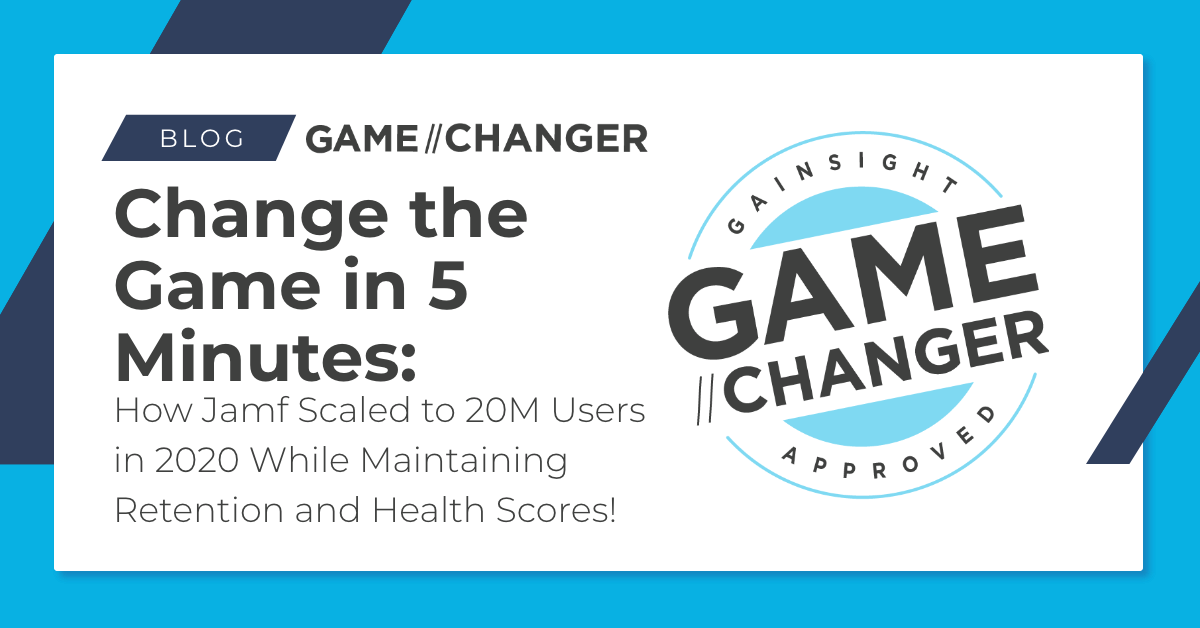Welcome to our Change the Game in 5 Minutes Series. Today, we are sharing lessons from Sam Johnson, Chief Customer Officer of Jamf, and Ben Michael, their Director of Customer Success. We wanted Sam and Ben to share their insights on driving scale and how they think about renewals. Also, is there something beyond their technology level that led to success? And what processes did they change to make all this happen?
Nick: Gentlemen, it’s great to see you both. We at Gainsight are fascinated by your significant milestones. In July 2020, Jamf debuted on the NASDAQ in a $100 million IPO. According to Forbes, it is considered one of the top 25 Apple-related brands. And your growth over the past five years has been phenomenal. First, Sam, give me an overview of Jamf.
Sam: At Jamf, we assist organizations in succeeding with Apple. What that means is we help people manage, connect and protect their Apple devices. Jamf is a bridge between the legendary Apple user experience and the enterprise demands of IT needs.
Nick: How did you grow and scale from a company that managed around 4 million devices for 5,000 customers in 2015 to managing more than 20M Apple devices for over 47,000 customers in just five years?
Sam: Nick, it’s been quite a ride. We set a vision in 2015 to empower twenty million people by 2020. But to hit that goal and direction, I knew we had to change. Coincidentally, 2015 was when we started using Gainsight.
Nick: That’s interesting. What changed and why?
Sam: We first thought about the ideal customer experience. We required more automation to accomplish our goals and create an environment where our CSMs could engage and impact customers. To scale, CSMs couldn’t do mostly administration work.
Often, people think about scale as an element of the business demand. However, it’s more important to consider the customer’s value and then work backward into the operations.
Nick: Amazing. Ben, having seen this process from a different lens, what was your “why” behind it?
Ben: Previously, our customer teams handled technical support, the renewal process, and the relationship. In customer success, having too many things on your plate, the customer relationship often falls off. Developing and improving the customer relationship became my task. Most organizations start their customer success journey by focusing on their top three to five percent of customers. We did the exact opposite, concentrating on customers who needed attention and examining how we could scale them. We removed the busy work of CSMs with an automation tool for value-added conversations and renewals, which was Gainsight.
Nick: What other operational motions did you focus on to make scale a reality?
Ben: Many companies want employees to wear many hats. That’s not possible. Jamf needed to specialize in areas serving customers, like support, CS, and renewals. Also, we began customer education teams who generate on-demand, online, and in-classroom content that enabled and drove customers to the CS arm.
The second part centered on bringing adoption value to customers as soon as possible. Once done, we paired them with user personas created by our marketing team. Then, we “rubber-stamped” motions and templates to follow those specific customers.
Nick: That’s an interesting point. I think that concept helps understand what value and time to value means for each persona. It also enables you to determine what your CSMs should be doing every day. Sam, is there anything you would like to add to this?
Sam: From an organizational structure standpoint, we were service oriented and had a reactive model. We desired to be more proactive throughout the entire customer journey. As Jamf scaled, we continued what we call pure CS functions. We built that team by constructing the CSM discipline that wasn’t embedded on the services side. We then paid attention to the connection that CSMs had to marketing and leaned heavily into our operations.
Nick: I love it! Now, share with me how Gainsight fits into your scaling process.
Ben: We began with a low-touch model. We figured out how to provide value to many customers with not many employees. We utilized the Journey Orchestrator outreach function in Gainsight. JO enabled us to have repetitive motions without personal conversations. It freed our CSMs’ time to have conversations with at-risk or larger customers.
We developed our customer success mindset knowing what Gainsight tools and functions could meet our needs. That enabled us to develop our first health scoring system. It also provided score revisions when the meaning of health changed for us.
Since then, Jamf has put more automation in place based on varied customer segments. We have a sliding scale for automation built on activities or triggers for each segmentation group. We achieve value for our customers, and it meets their needs based on their segment.
Nick: Health scores are something everyone wrestles with, especially defining what one is. How did you develop health scores, and what learnings did you have from that?
Ben: Our initial health score was based on a reactive mindset. As a support organization, we thought that it was a good thing when customers weren’t talking to us. That meant they were happy. If customers aren’t talking to you, that means things are bad. We also looked at the number of support cases, and if they were low, it would be a healthy situation. We now incorporate more factors indicating health, such as product usage and telemetry data about how customers use our products. There is also a specific metric based on how customers feel. If they’re not talking to us but using the product every day, you feel more confident about their health.
Our current health score is based not only on usage telemetry data but also enrollment because it’s a device-based solution. The score also looks at how many executive communications we have and how many touchpoints with leaders. Our small market customers don’t require as much contact to be healthy. In contrast, our enterprise-level need to have a regular talk track with our leaders to remain successful.
Nick: Can you give me examples of workflows you found you could automate and how automation helped overall?
Ben: The great emphasis was automating our renewal process. Adding 40,000 customers in the last five years required streamlining the renewal process. Rather than sending out blanket emails from various teams, we partnered the CS team with the account sales team. Prospecting emails are sent to existing customers meeting specific health criteria thresholds for high propensity growth. When the customer responds, we have a conversation with them.
Customers who don’t respond have a different automation path. They get their renewal quote, and hopefully, they renew with a low lift from a human. If they’re happy and healthy, they pay the bill, and all is well.
Nick: I think that’s very practical and is textbook Gainsight success. Ben, if somebody is early in their Gainsight journey, what are some best practices to give?
Ben: One of the most important aspects of completing tasks in Gainsight is to make sure the team using the tool you’re building or backing up has buy-in and understanding. I want my team to be as excited as I am about the product and process.
Nick: Sam, thinking about results, what are you most proud of?
Sam: From a value perspective, Jamf increased our NPS scores throughout our entire journey. Incredibly, it now sits in the 50s, and we are trying to improve that from a performance standpoint. Last year alone, we onboarded over 11,000 customers. Operating at that scale was not tenable before, no matter how many people we put in front of it. That would not have been possible without all the work Ben has been doing.
From a business perspective, we’ve maintained our net retention and keep our churn under control consistently. But when we acquired three different companies and implemented those product lines into our business, the complexity increased.
As for the efficiency side, people often look at the CSM to customer ratio. Jamf has so much segmentation that we have improved our tech touch area dramatically through pooled resources. That allows other areas, like strategic accounts, to invest more heavily and get more attention.
Nick: One last question, as you look forward to the future, what are your goals and what you can do with Gainsight specifically?
Ben: My focus is on the CS function in operations almost exclusively. We’re building a consistent output for our teams internally by helping them be successful and continue to grow. Another thing I’m excited for is a new addition to our product portfolio. It’s integrated into all of our internal systems. We’re using Gainsight to help bring that in to empower our teams. They will have more information about adoption utilization on accounts in a way they never had before. They’re going to be able to provide verified adoption information through communications, plus data letting us know how successful customers are with our products. Gainsight will help us continue to maintain and improve the retention of that new product portfolio and even accelerate growth, a crucial metric.
Nick: This has been great. Thank you for sharing this story about your incredible success. Sam and Ben, congratulations.

